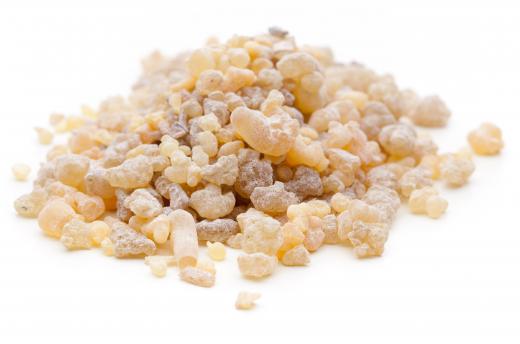Resin is a natural or synthetic compound that begins in a highly viscous state and hardens with treatment. Typically, it is soluble in alcohol, but not in water. The compound is classified in a number of different ways, depending on its exact chemical composition and potential uses. It also has many applications, ranging from art to polymer production, and many consumers interact with products that contain it on a daily basis.
Natural resin comes from plants. A classic example is pine sap, which has the characteristic sharp odor of terpene compounds. As anyone who has interacted with pine sap knows, the substance is very viscous, but it hardens over time. A number of other plants produce resins, and they have been used by humans for thousands of years. Some plants exude a similar substance called gum or gum resin that does interact with water. Gum tends to be softer and more malleable.

Plant resin can be clear to dark brown in color, and it varies in opacity and hardness. Some is also extremely volatile, since it contains unstable compounds. Misidentification of resinous trees can sometimes lead to unfortunate accidents, since some contain heptanes, which are flammable and potentially explosive hydrocarbons. The popular decorative material amber is fossilized plant resin. It is most often found in a rich golden color, which is a common shade for plant resins, but amber can also be found in more rare colors, like blue.

Humans have been using natural resins for thousands of years. Pine pitch has been used to seal boats, mummies, food containers, and an assortment of other things. It has also been used as a component in varnish, lacquer, inks, perfumes, jewelry, and many other objects. With human technological advances came the realization that this material could be formulated into polymers, and the discovery of synthetic resins followed shortly after.

For the most part, polymers made with “resins” are actually made with synthetics, which are cheaper and easier to refine. Synthetic varieties are much more stable, predictable, and uniform than natural ones as well, since they are made under controlled conditions without the possibility of the introduction of impurities. They are made by combining chemicals in a laboratory to stimulate a reaction which results in the formulation of a resinous compound. Once formed, the substance can be used in the production of plastics, paints, and many of the same substances that natural resin is used in.
Ever since she began contributing to the site several years ago, Mary has embraced the exciting challenge of being a About Mechanics researcher and writer. Mary has a liberal arts degree from Goddard College and spends her free time reading, cooking, and exploring the great outdoors.

